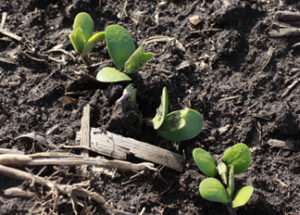
Planting Basics to Get Your Soybeans Off to the Best Start Possible
Now that a fair amount of corn acres have been planted it is finally time to move to soybeans.
Planting Date and Flowering
Soybeans show yield response to being planted earlier because they are indeterminate plants. This means that they do not have to reach a certain size or stage before flowering, they can flower and grow at the same time. All soybeans will start reproductive stages at the same time. They are triggered to begin flowering due to changes in day length after the summer solstice (flowers usually show up after the 4th of July). From true V1 (1st trifoliate leaf) to R3 (beginning pod), soybeans will put on an average of one node every 3.7 days.Flowers are located only at nodes so the more nodes we have the more flowers we can put. The beans that are planted earlier and emerge earlier will have an edge when it comes to number of nodes and therefore yield. Late planted soybeans can lose an average of 0.5/bu / day.
Delayed Planting and Population
Delayed planting reduces the number of days for soybeans accumulate nodes, and therefore reduces the potential maximum number of pods. To counter act this, we suggest growers increase their planting rates. By increasing the totally number of plants in the field, we are increasing the amount of nodes present to create flowers and pods. If planting is delayed from May 1st-May 10th to May 20th to June 1 instead – increase your population 15-18%. Example, if you’re originally planning on 140,000 seeds/ac, increase your population to 160,000-175,000 seeds/ac. Consider switching soybean maturity by .5 to 1.0 after June 10th.
Soil Temperatures
Soil temps of 77-86 degrees bring on the most rapid and consistent soybean emergence. In reality it is not practical to wait for these temps in Iowa as they usually show up mid to late June. Soybeans will begin to germinate at 50 degrees but damage can occur quickly below 45 degrees. I always suggest a buffer of a few degrees and shoot for soil temps to be 55-60 degrees before planting soybeans.
Germination
Soybeans will take up as much as 100% of their weight in water during germination. It is important to make sure there is enough water in the seed bed for this process to happen. Saturated soils can lead to a host of disease issues but soil that is too dry can also significantly delay emergence. If the forecast is for continued dry weather, consider planting a little deeper. This will help to grab soil moisture that may be lower in the profile. I often suggest 1.5” depth in normal soil conditions and 2” in dry conditions.
Weed Control
It is crucial to begin the season with a residual pre-plant or pre-emergence application. This helps to control early weeds that would otherwise compete with the crop as it becomes established. To extend the control over weeds with large emergence windows such as waterhemp, use a residual in the post-emergence pass as well.
